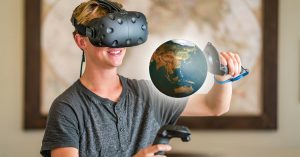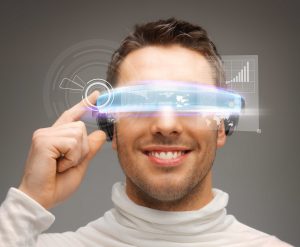In this last task we were asked to consider what we have learned over this course and create two speculative narratives about our potential relationship with media, education, text and technology in the next 30 years.
The speculative futures I have created are based on creating interactive and personal experiences between the individual and the technology. They present an idea of what could be designed and created to provide a solution to a problem. As mentioned by Dunne and Raby (2013) Speculative Everything: Design, Fiction, and Social Dreaming, the curator Paola Antonelli suggests, “We might see the beginnings of a theoretical form of design dedicated to thinking, reflecting, inspiring, and providing new perspectives on some of the challenges facing us.” (p. 88).
AR and VR have the potential to be game changers for the education and healthcare industries and will help make our classrooms a more engaging and healthier place to be.
Speculative Future #1:
Virtual Reality view of being transported into the life of a student in a developing country.
The first speculative future I have created is based on an immersive experience of students in other parts of the world in order to experience how they live and their educational experiences.
Imagine: “Wake up Francis!” comes a voice from upstairs. Francis reluctantly wakes up and makes his way upstairs for breakfast. As he slowly climbs the stairs, he mutters under his breath that school sucks and that he doesn’t really see the importance of an education. His mom ignores his complaints and tells him to hurry up or he’ll miss the bus. Francis quickly eats his breakfast and is soon out the door and on his way to school.
Francis and his bad attitude makes it to school and into his first block where his teacher asks the class to take out their books. Francis sits and refuses and proceeds to ask his teacher, “Why do I need an education anyways?” Francis’ teacher takes this as a great learning opportunity and takes out the VR headsets to give the students a quick lesson on why an education is so important.
Upon putting on the headsets, Francis and his fellow students are quickly transported into the life of a student in one of the townships of Capetown, South Africa. Francis soon gets to experience the life of a student in the developing world and the difficulties they must go through just to get an education. Students will be working through a new health initiative called, “Walk In Their Shoes,” which will be made all the more powerful through the use of VR.

https://www.viar360.com
Speculative Future #2:
Mindfulness for the Soul
Currently we have apps that we can download with lessons and inspirations to quiet our mind and be more mindful. We have reminders that pop up on our mobile devices that can suggest we take a break or find a quiet moment. Perhaps we can jump to the future and imagine this taking on a more interactive approach, where instead of simply having a suggestion on an app, we instead have multiple pieces of technology that will work in coordination to provide an interactive assistant to actually help guide us in slowing down, taking a breath and help guide us through the strategies needed to help us regulate.
Imagine: Frank is sitting in class when all of a sudden he starts to feel his anxiety kick into high gear. Immediately his smartwatch picks up his increased heart rate and sends an alert to the TTC (Time To Chill) app that is installed on his Google Glasses. Frank’s glasses turn on and he engages in some augmented reality relaxation techniques.
Frank’s teacher sees that he is not doing his work but quickly realises that he is taking time to relax so that he can get his anxiety in check and return to optimal learning mode. Seeing as how educators realize the importance of mental wellness, this is not a problem and Frank is given time to get regulated and prepared to join the class once his anxiety is under control.
It’s great to have apps and for teachers to take time out of the day to teach mindfulness, but in the classroom of the future, students will have real time help to gain control of their anxiety and stress. This seamless integration of technology will be a timesaver and mental health breakthrough for students.

https://elearningindustry.com/
References:
Dunne, A. & Raby, F. (2013). Speculative Everything: Design, Fiction, and Social Dreaming. Cambridge: The MIT Press. Retrieved August 30, 2019, from Project MUSE database.
I like the idea of technology that monitors students stress levels. I could see the technology being useful if it could also automatically, like ping the teacher at the same time (“incoming message: We’ve detected increased stress signals from Frank”). Do you think a potential consequence could be a reduction of self-regulation skills from students, if they’re relying on their apps to detect their emotional states?
Great question. I had the same thought as I was considering this type of technology. However, this is really just another tool in the toolbox of strategies that we could use with students. Even though this is far into the future we still need to try to utilize a variety of regulation strategies with students in order to find out which tool will help the best.